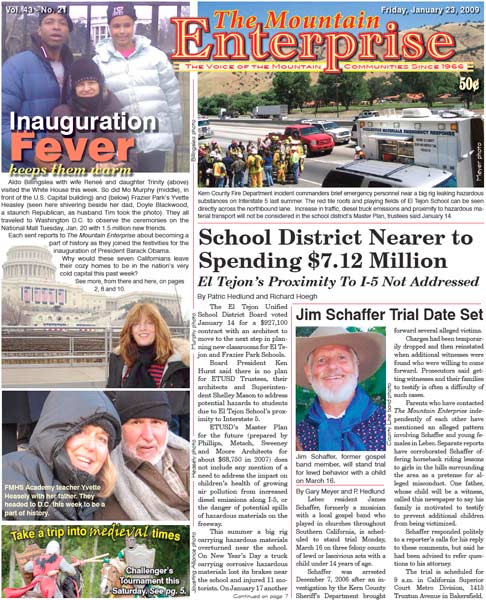At the end of the business day on Friday, Jan. 23—in the week which also saw the inauguration of a new president—the U.S. Fish and Wildlife Service (USFWS) sent out a press release alerting editors that a document has been published in the Federal Register to begin the public review and comment period about what promises to be a highly controversial Environmental Impact Statement (EIS) regarding the critical habitat of the endangered California condor.
According to Lois Grunwald of the USFWS, the Obama administration ordered all such publication to be halted while the new administration reviews what has been put into the pipeline by the outgoing administration. "Such an order is not uncommon," Grunwald said, adding that most incoming administrations issue orders to freeze Federal Register publication of such items during a transition review period.
"But somehow the EIS slipped through the cracks and got published last week," Grunwald said. Tejon Ranch Company’s conservation plan for habitat of the California condor (and a score of other threatened and endangered plant and animal species) did not get published in the Federal Register along with the USFWS impact statement, she said. The USFWS has placed both documents on their website however. [See URL below.]
The footprint of Tejon Ranch Company’s proposed Tejon Mountain Village puts 3,500 homes, resort hotels and commercial areas partially within critical habitat for the condor and other listed species.The Fish and Wildlife Service’s Environmental Impact Statement explains the agency’s evaluation of Tejon’s plan to protect the habitat while proceeding with its development and ranching activities.
Public review and comment on the Environmental Impact Statement is solicited until April 22. Public input on Tejon Ranch Company’s habitat conservation plan (HCP) can also be submitted within that period, but an additional public review and input period will be announced once the HCP is officially published in the Federal Register, Grunwald said.
The statements and plan are required as part of Tejon’s request for an "incidental take permit" to disturb or cause the death of threatened or endangered species. On June 4, 2008, Tejon Ranch Company issued a statement saying "the proposed Tehachapi Uplands Multi-Species Habitat Conservation Plan, which would require the approval of the U.S. Fish and Wildlife Service, provides comprehensive protection for 34 different species of plants and animals that inhabit the Tehachapi Mountains…."
The statement emphasized that Tejon Ranch is not seeking a lethal take permit for the California condor. "The characterization by some of the TUMSHCP as ‘a license to kill condors’ is therefore inflammatory and false," the Tejon statement declared, adding that hunting is not classified as a “covered activity” under the MSHCP. This is a sensitive issue, because the most experienced remaining condor born and matured in the wild—a matriarch known as AC-8 that was critical to the condor preservation program—was killed by a pig hunter on the ranch in February 2003.
Condor are intelligent and curious birds that are highly unusual in that they spend their first eight to nine years learning from older birds about their habitat before they begin reproducing, according to interviews with wildlife biologists. The loss of the matriarch that had spent about 58 years learning the upland ridges and plains that provided traditional roosting and foraging habitat for the endangered species was a major loss to the restoration program. Today there are roughly 80 of the iconic birds left flying free in the state.
The unique behaviors of the condor are frequently overlooked in statements made by developers about the compatibility of overlapping human commercial activiities and critical habitat, according to some involved in the condor reclamation effort.
This is a direct link to the draft EIS [Editor’s Note: On Friday afternoon at 5 p.m. The Mountain Enterprise staff noticed that some links in this URL are not functional.]:
www.fws.gov/ventura/endangered/hconservation/hcp/hcfiles/TehachapiUpland/index.html
This is part of the January 23, 2009 online edition of The Mountain Enterprise.
Have an opinion on this matter? We'd like to hear from you.


